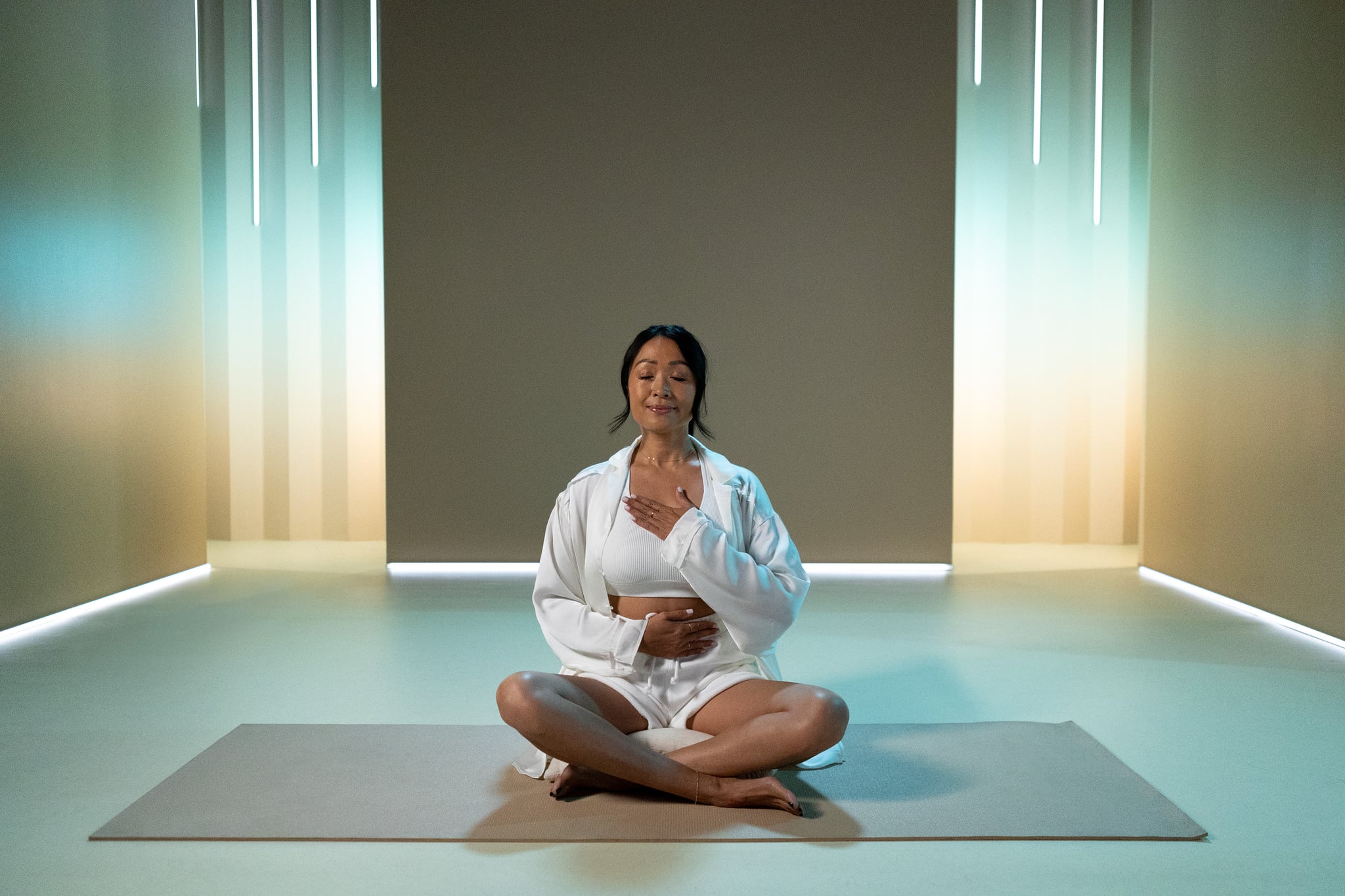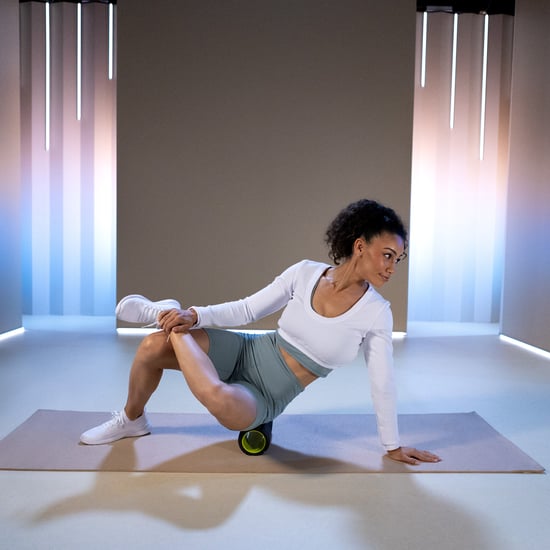What Is Breathwork?
Breathwork Can Help You Inhale and Exhale Your Way to a Better Mindset

You may think you have this whole "breathing" thing taken care of. After all, it's one of those processes that's (thankfully) automatic and (thankfully) doesn't take up space on your to-do list. But breathwork — a practice of being a little more intentional with your inhales and exhales — is a way to get even more out of one of your body's most essential processes.
"Breathwork is deliberately engaging the breath in an exercise or technique that alters our physical and mental state in some way," says Alo Moves mindfulness and meditation instructor Jackie Stewart. If you've ever decompressed with a huge inhale followed by a dramatic sigh (exhale), congratulations, you've unknowingly engaged in a form of breathwork.
Ahead, Stewart offers a convincing argument for building an ongoing relationship with your breath that will serve you in good times and bad times. Plus, a few exercises to help you next time you find yourself in an SOS moment or just want to take a second for yourself.
The Benefits of Breathwork
Pencilling breathwork onto your calendar serves to calm the physical body and the mind. "Breathwork is a powerful tool that helps re-establish the mind-body connection," says Stewart. "When we breathe deeply, we are sending a signal to our brain and body that we are safe in this moment. This allows the nervous system to shift from flight or fight — sympathetic — to rest and digest — parasympathetic, which is our natural state."
The parasympathetic system releases the hormone acetylcholine, which causes the heart rate to slow. It also lowers our blood pressure and increases gastric secretions (lovely), which promote proper digestion. All of this amounts to a body that's a little more chill, present, and ready to engage with the world.
"When our parasympathetic nervous system is activated, we feel more relaxed, curious, and engaged with the world around us. Our perspective can widen, and we can begin to consider the experiences of others," says Stewart. Research shows that breathwork may also boost your moods, increase focus, and decrease stress and anxiety.
Breathwork Exercises for Beginners and Non-Beginners
Lucky us: breathwork exercises tend to be straightforward and easy to learn. "For me, the quickest and most simple breath work practice is one that can be done on the spot, anytime, anywhere," says Stewart. "When we notice we're caught in a moment of tension, pausing to take a breath can offer an instant release, and be a way for our body and mind to shift gears on the spot."
This one mega-inhale and exhale brings us back to right now and gives us a chance to really consider what we want or need to do next. "Each time we do this, we are starting to make a habit out of this very simple, effective act. It is a way for us to connect with our nervous system, bringing us out of a more reactionary mode and allowing us to settle into a more balanced and spacious way of relating," Stewart says.
Below, Stewart offers three basic breathwork exercises to keep in your back pocket (beyond the one-deep-breath practice).
Box Breathing
"This exercise is called box or square breathing because we'll essentially be making a square with our breath by breathing in, holding, exhaling, and holding while counting to four each time," says Stewart. "This breath can be particularly supportive if we find ourselves getting caught up in destructive thoughts. It helps interrupt that pattern and redirects our attention, keeping us focussed on deep, slow breathing." Here are her directions for box breathing:
- Find a comfortable seated position, allowing the spine to be straight. Keep your muscles relaxed. You can close your eyes if you like or soften your focus. Begin by allowing the body to settle and letting the breath be natural.
- Take your first inhale, breathe in for 4 seconds, hold the breath at the top for 4 seconds, exhale for 4 seconds, and hold for 4 seconds before taking that next breath in.
- Repeat this cycle a few more times, finding a rhythm with the breath.
- Inhale for 4 seconds, hold, exhale, hold.
- You may eventually let go of the counting and simply notice each phase of the breath.
- Then, let the box breathing go, and allow your breath to be natural again.
- Take a moment to notice how you feel.
Full Body Breathing
- This practice can be done lying down or sitting upright. Relax your muscles and close your eyes if that feels comfortable. Begin feeling the natural rhythm of your breath coming and going. We can very intentionally start to circulate the breath, imagining we could breathe into various parts of our whole body.
- Begin by bringing the breath into all the muscles of the face. Imagine that we could enliven these muscles with our breath.
- Continue moving this breath around, bringing it down to the neck and shoulders — feeling as though this breath could begin to wake up the body.
- Let this breath continue down into your arms, into your hands, and extending to the tips of your fingers.
- Moving the breath now through your torso, allow it to awaken the feeling of your chest, down to your belly, and around to your entire back side. Allow your breath to travel up and down your back.
- Bring the breath down into your hips and extend this breath into your thighs, your lower legs, down to your feet, and to the tips of your toes.
- Continue breathing and notice where the breath naturally begins to flow.
After the practice, Stewart recommends noticing how things have shifted. Do you feel more attuned to a certain part of your body? Do you feel more awake? More grounded?
3-Part Breath
"This breathing technique can be done sitting upright or lying down, so feel free to find a position that works well for you," says Stewart. " This exercise guides us in intentionally engaging our breath, moving from shorter, quicker breaths to diaphragmatic breathing, which can help oxygenate and nourish our whole body."
- We'll begin by bringing our attention to how our breath is right now without changing anything about it. Just notice your normal breath in this moment.
- From here, begin to deepen your inhales and exhales, making sure your breath remains smooth and unstrained.
- As we continue to breathe deeply in and out through the nose, feel as though you could bring your next inhale all the way down to the belly, filling it up with air. And then, on the exhale, releasing this air, emptying out your belly completely, and drawing your naval to your spine. Continue with these deep belly breaths for the next few cycles, keeping your breathing comfortable and even.
- We can think of breathing down into the belly as part one of our breath. Now, we'll add on part two.
- Breathe down into the belly, just as we did before. This time, when the belly is full, we'll inhale just a little more air, allowing this breath to expand the rib cage. As you exhale, release the air from the rib cage first, then the belly until it's empty. Repeat these two stages of breath — belly then rib cage, and then releasing the rib cage then belly — for a few cycles.
- On your next inhale, breathe down into the belly. Expand the rib cage, and then inhale just a little more air, filling your upper chest area to the collarbone. You might even think of this third part as breathing into your heart, which can cause the chest to rise a bit. On the exhale, allow the chest to drop back down, releasing the ribs and emptying the belly. Practice doing all three parts — belly, ribs, chest — and then releasing the chest, ribs, and belly for a few cycles in your own time.
- Release from this exercise entirely and allow yourself to breathe in a way that feels easy and simple.
- Notice how you feel. Bring awareness to how your body and mind feel after taking some time to breathe deeply.
Breathwork Can Be a Gateway to Meditation
Breathwork is central to most meditation practices. If you're looking to build on the breathwork foundation you're building, give a guided meditation a try. Below, find an intention-setting meditation from breathwork therapist Kristina Joy.






